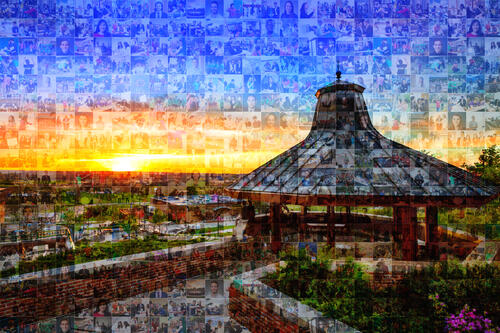
Envision particles, suspended in fluid, all colliding with one another because of the fast, furious movement of surrounding molecules.
For scientists, that scene illustrates a dynamic known as Brownian motion. At the SUNY Geneseo Center for Integrative Learning (CIL), particles bouncing off each other and releasing energy is a metaphor for the work of CIL.
“CIL is a collision space that energizes everybody,” says Director Lytton Smith, who is also an associate professor of English and creative writing.
How does CIL energize? Through interdisciplinary study and community engagement.
The value of interdisciplinary education is clear to Sabrina Bramwell ’19. Who majored in English while on a pre med track, Bramwell says she was “always battling, trying to get other people to see how English and medicine are one and the same.”
Then she took a course developed with, and supported by, CIL—one that combined geology and speculative fiction. The class strengthened her perception that sciences and humanities were complementary.
“If you look at history, you see that many scientists have illustrated technical concepts using literature or poetry,” she says. “We were reading books and talking about rocks mentioned in the text. And that connection between literature and science became obvious.”
Junior Jillian Todd had a similar experience. She started out as a dual biology and physics major, but other disciplines also called to her. She took CIL-supported classes that helped her combine her interests. Now a Women’s and Gender Studies major, she says: “I love having interdisciplinary classes where I can use complex physics metaphors to talk about gender and sexuality. It’s such a beautiful storm when I can bring all these pieces together.”
This kind of interplay between fields as seemingly different as English and science is precisely the point of CIL, according to Smith. But he says the center’s focus is not solely on the relationships between disciplines. Connections between scholarship and residential life, and between academics and community partners, are also emphasized. For example, CIL supports the Together Program, in which Geneseo students partner with members of the local Spanish-speaking population to teach adults and grade-school children English skills. In return, students get to practice their Spanish conversation skills. This mutually-beneficial scenario, developed by the Center for Languages & Cultures at SUNY Geneseo, helps students meet the College’s mission: becoming “socially responsible and globally aware citizens.”
The Together Program requires students to draw on disparate skills, which teaches them to synthesize knowledge. That’s helpful, Smith notes, because “the graduates of today are likely to have several careers. So we want them to be able to apply their skills to jobs that don’t even exist yet—but will in a few years.”
That approach worked for Bramwell, who is now an admissions counselor at SUNY Geneseo. “Learning in the way I did gave me an interdisciplinary mindset that makes it easier for me to channel conversations with students and parents,” she says.
Bramwell remembers a student who was studying health but also took classes in philosophy and literature. The student’s parents were dismayed that they weren’t spending every day in the lab. Bramwell says she explained to them that “caring about people is an important part of healthcare, and the humanities tap into that.”
Bramwell also hears from students who want to double major, in, say, music and biology. Bramwell responds enthusiastically: “Yeah, let’s talk about it!” She notes, “Not all schools offer that, but here, the center helps make it possible.”
Summing up the opportunities offered by CIL, Smith returns to his metaphor of those colliding particles. “The center is about recognizing moments of novel connection and possibility that emerge,” he says. “The goal is to let students explore new things.”
(Upper right photo: Sabrina Bramwell '19; lower left photo: Jillian Todd '21)